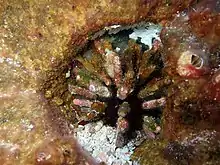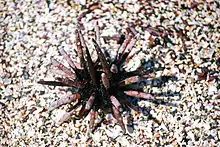| Eucidaris thouarsii | |
|---|---|
 | |
| Eucidaris thouarsii in the Gulf of California | |
| Scientific classification | |
| Domain: | Eukaryota |
| Kingdom: | Animalia |
| Phylum: | Echinodermata |
| Class: | Echinoidea |
| Order: | Cidaroida |
| Family: | Cidaridae |
| Genus: | Eucidaris |
| Species: | E. thouarsii |
| Binomial name | |
| Eucidaris thouarsii (Agassiz & Desor, 1846) | |
Eucidaris thouarsii, the slate pencil urchin, is a species of cidaroid sea urchins that inhabits littoral regions of the East Pacific Ocean.[1][2]
Distribution and habitat

Eucidaris thouarsii is found in the East Pacific at depths of 0–45 m (0–148 ft), ranging from Baja California to Panama, as well as Cocos Island, Clipperton Island and the Galápagos Islands.[3][4][5] The Galápagos, Clipperton and Cocos populations are now often recognized as a separate species, E. galapagensis, instead of a subspecies of E. thouarsii.[6]
Diet
Like all urchins these are primarily herbivores, but feed on a wide range of invertebrates.[7] This species has a high nutrient absorption efficiency when it comes to the coral Pocillopora damicornis, but would require a large intake to make nutrient requirements.[8] Due to its high intake of coral, it reduces reef growth.[9]
References
- ↑ Encyclopedia of Life. "Details for: Eucidaris thouarsii". Encyclopedia of Life. Retrieved 2013-07-23.
- ↑ Kroh, A.; Mooi, R. "Details for: Eucidaris thouarsii". World Echinoidea Database. Retrieved 2013-07-23.
- ↑ Glynn, Wellington, and Birkeland (1979). Coral reef growth in the Galapagos: limitation by sea urchins. Science. 203(4375): 47-49.
- ↑ Natural History Museum: Eucidaris thouarsii. The Echinoid Directory. Retrieved 11 September 2014.
- ↑ Reyes-Bonilla, and Calderon-Aguilera (2002). Population Density, Distribution and Consumption Rates of Three Corallivores at Cabo Pulmo Reef, Gulf of California, Mexico. Marine Ecology 20(3-4).
- ↑ Lessios, Kessing, Robertson, and Paulay (1999). Phylogeography of the pantropical sea urchin Eucidaris in relation to land barriers and ocean currents. Evolution 53: 806-817.
- ↑ Baumiller, Tomasz K. (2008). "Crinoid Ecological Morphology". Annual Review of Earth and Planetary Sciences. 36: 221–49. Bibcode:2008AREPS..36..221B. doi:10.1146/annurev.earth.36.031207.124116.
- ↑ Lawrence, John M.; Glynn, Peter W. (1984-01-01). "Absorption of nutrients from the coral Pocillopora damicornis (L.) by the echinoid Eucidaris thouarsii (val.)". Comparative Biochemistry and Physiology A. 77 (1): 111–112. doi:10.1016/0300-9629(84)90020-3. ISSN 0300-9629.
- ↑ Glynn, Peter W.; Wellington, Gerard M.; Birkeland, Charles (1979-01-05). "Coral Reef Growth in the Galápagos: Limitation by Sea Urchins". Science. 203 (4375): 47–49. Bibcode:1979Sci...203...47G. doi:10.1126/science.203.4375.47. ISSN 0036-8075. PMID 17840510.
External links
- Encyclopedia of Life. "Details for: Eucidaris thouarsii". Encyclopedia of Life. Retrieved 2013-07-23.
- Kroh, A.; Mooi, R. "Details for: Eucidaris thouarsii". World Echinoidea Database.
- Photos of Eucidaris thouarsii on Sealife Collection